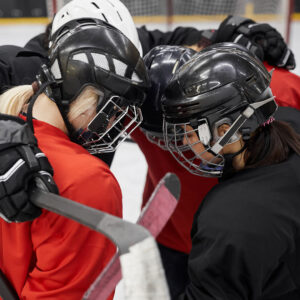Original story posted here.
Sport specialization is occurring, whether we admit it or not, writes Kody Blois. And there’s plenty of evidence to suggest that it’s not what our kids need.
As a young athlete, I was fortunate enough to be able to pursue my passion in sport 12 months of the year.
In September, I would eagerly strap up the goalie pads, excited for a new hockey season to begin. In April, as the hockey season was winding down, I was dreaming of summer, and excited to ply my trade on the softball diamond or soccer field.
Even today as an adult, I look forward to the transition from beer-league hockey to golf in the summer. I suspect many reading this article may have the same sentiment as individuals who enjoy multiple sports.
Anyone familiar with amateur sport today should be concerned that sport specialization is preventing the next generation of young athletes the same opportunity to genuinely enjoy and pursue multiple sports throughout the calendar year.
This past weekend, a dozen young athletes in my community were forced to choose between two sports they love: hockey and softball. On a warm weekend in the middle of August, our local community could not field a team at the U-16 Eastern Canadian Softball Championship because several of the athletes are also top hockey players. Tryouts for major midget and major bantam hockey teams were being held that same weekend, forcing these kids off the ballfield and into the hockey rink.
It is important to recognize that this is not an isolated case in rural Nova Scotia. All across the country, young athletes in all sports are increasingly faced with the reality that one respective sport is demanding nearly a 12-month-a-year commitment. Whether it is top athletes in hockey, baseball, soccer, or otherwise, the new expectation is full-time commitment, leaving very little room for other sports, let alone passions and hobbies outside of the game.
The increasing trend towards sport specialization is happening despite significant research and dialogue suggesting it is the exact opposite of what we want for our kids.
The American Orthopaedic Society for Sports Medicine released a study in 2016 finding that early sport specialization is believed to be unhealthy physically and mentally for young athletes.
Wayne Gretzky, Bobby Orr, and a several professional athletes across a wide spectrum of sports have spoken at length about the benefits of playing multi-sports. Hockey Canada has even released a #changeitup campaign, aimed at promoting the benefits of young athletes playing multiple sports outside of hockey.
While the discussion and dialogue has been beneficial, the tangible action taken to create an environment allowing athletes to play multiple sports is negligible.
A case in point is the hundreds of young athletes in Nova Scotia, aged 13 to 15, who were required to try out for their respective major bantam and major midget hockey teams in the middle of August.
This is where national and provincial sport organizations such as Hockey Nova Scotia are well placed to take a leadership role and work in collaboration with other provincial sport organizations to ensure that respective sport seasons do not infringe upon one another.
Why does midget and bantam hockey need to start in August? Why not restrict pre-season play until after Labour Day weekend, creating a window for athletes to pursue a summer sport, and giving the parents an additional few weekends of summer before a winter filled with trips to the rink? While the examples I am providing are hockey-related, the principles and messaging is applicable across all sports.
It is apparent that the trend toward sport specialization has meant that athletes, and the parents supporting them, are encouraged to spend more and more time pursuing their respective sport during what used to be considered “off-season.”
There is no doubt athletes should have the individual liberty to choose when and how much time they dedicate to their respective sport; alternatively, those who wish to pursue multiple sports need protection from provincial sports organizations to adequately allow them that same freedom.


